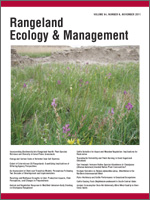A comparison of animal gains and vegetation trends was made from 2002–2008 between a continuous season-long stocking (SLS) system and a modified intensive–early stocking system (IES) with late-season grazing (IES 1.6× 1; 1.6 times the number of animals of the SLS system from May 1 to July 15, and 1 times the number of animals of SLS from July 15 to October 1) on shortgrass native rangeland of western Kansas. The continuous season-long stocked system placed animals at a density of 1.37 ha · steer−1 from May through October, or 2.63 animal unit months (AUM) · ha−1, whereas the intensive–early stocked system with late-season grazing (3.33 AUM · ha−1) stocked pastures at 0.85 ha · steer−1 from May through the middle of July, and then stocked pastures at 1.37 ha · steer−1 for the remainder of the grazing season by removing the heaviest animals mid-July each yr. Average daily gains (0.78 vs. 0.70 kg · d−1, P = 0.039) and total animal gain (58 vs. 52 kg, P = 0.042) were different between the continuous season-long stocked and the intensive–early stocked animals during the first half of the grazing season. No difference was found between average daily gain (0.61 vs. 0.62 kg · d−1, P = 0.726) and total animal gain (48 vs. 49 kg, P = 0.711) for the continuous season-long stocked and intensive–early stocked with late-season grazing animals during the last half of the season. Total individual animal gain (106 vs. 101 kg, P = 0.154) and average daily gain (0.70 vs. 0.66 kg · d−1, P = 0.152) was not different between the continuous season-long stocked and the intensive–early stocked system animals that were on pasture the entire grazing season. Total beef gain on a land-area basis (96 vs. 77 kg · ha−1, P = 0.008) was greater for the modified intensive–early stocked system with late-season grazing with greater animal densities. Changes in residual biomass and most key vegetation components at the end of the grazing season were not different between the two systems.
How to translate text using browser tools
1 November 2011
Animal and Vegetation Response to Modified Intensive–Early Stocking on Shortgrass Rangeland
Keith R. Harmoney,
John R. Jaeger
ACCESS THE FULL ARTICLE
basal cover
beef production
litter cover
residual biomass
season-long continuous stocking
stocking systems





